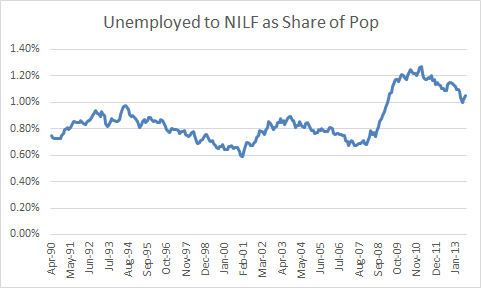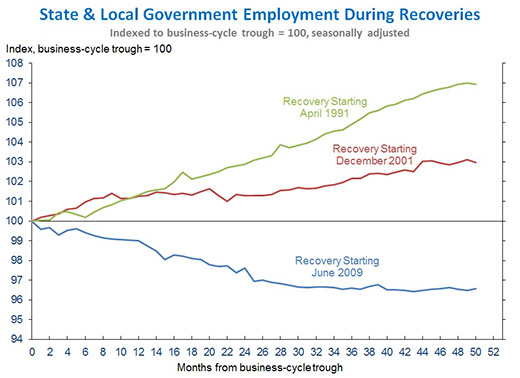It's now pretty well understood that of the two ways you can reduce unemployment, we got the bad one today. That is, the jobless rate can fall because more jobseekers land jobs -- good; or because they give up looking -- bad.
Today's tick down was of the latter type. The labor force participation fell two-tenths of a point to a level we haven't seen in decades. Some of that decline is demographic -- our workforce is comprised of a growing share of workers on the cusp of retirement. But most of it -- I'd say about two-thirds based on the analysis I've seen -- is due to weak labor demand.
Which led me to the interesting labor force flows data, of which one component is: the number of workers who leave unemployment not for work, but for NILF -- not in labor force. That's the person who gives up looking. (I discuss the flows data here.)
It's obviously a counter-cyclical variable (the economy tanks--this share goes up), but boy did it take off in this downturn compared to the prior two for which we have data. The figure plots the number of persons who left unemployment for NILF as a share of the adult population, using a three-month average to smooth it out a bit.

Source: BLS, 3-month moving avg.
As you see, it's coming back down -- fewer of the unemployed are dropping out (to give you a sense of the underlying numbers, we're talking about around 2.6 million persons last month). But it was so elevated in the Great Recession -- and, of course job growth hasn't been that strong, so the pull to stay in the search weaker than it should be -- that there's still a historically large share of the unemployed leaving the job market each month.
Though I don't know who these unemployed peeps are, I figure a bunch of them must be the long-term unemployed, of which we also have a much larger share than in past recessions/weak recoveries. In other words, I'd hypothesize that simply having a larger share of long-term unemployed means you'll see more people making this unfortunate transition.
One other point about the jobs report worth noting. Though there was a spike in local public education jobs last month -- up 20,000 -- the loss of public sector jobs has been unique drag on this recovery. The chart below, from the President's CEA, shows how markedly worse this trend has been. Had we not lost all those state and local jobs, the jobless rate would be below 7 percent according to the CEA. Had the trend in these jobs -- teachers, cops, firefighters, maintenance personnel--been like that of the last two recoveries, as shown in the figure, the jobless rate would be down a point.

Source: CEA
